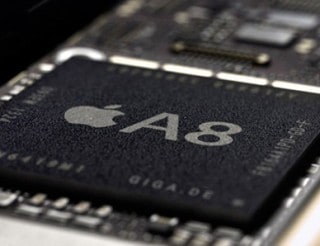 Apple has achieved great success while consistently pushing each iPhone iteration in the market and now, there is one more to hit the stores.
Apple has achieved great success while consistently pushing each iPhone iteration in the market and now, there is one more to hit the stores.
You might have noticed the buzz surrounding the new Apple A8 processor, and the much-awaited iPhone6, and the ensemble of improved features they are likely to toss at us. Whilst, many tech-savvy individuals have shared the anticipated features of iPhone 6, but very few have focused on the upcoming system-on-chip: Apple A8 Processor.
Let’s have a look at what improved features is Apple slated to introduce with the CPU of iPhone 6 – Apple A8.
1. Enhanced frequency – greater than 2.0 GHz per core
Apple is admired for its speed, it has incessantly offered great features since its very first release that had single core 90nm semiconductor, which runs at 412 MHz. It has also been successful in reducing the size from 90nm to 28nm and increasing processor speed from 412 MHz to 1.4 GHz, along with all the necessary iterations of processor. Hence, it is expected that Apple will enhance the speed, power and efficiency with better and advanced design.
Processor A8 is expected to come with improved CPU frequency of 2.0 GHz or greater per core with 2 highly efficient ARMv8-based CPU cores, and it might feature the same dual core, 64-bit architecture as that in A7 processor. It is expected to replace the Samsung 28nm node with TSMC 20nm node, and this significant size reduction will definitely help deliver outstanding performance.
2. Number of cores
There is a probability that Apple can move from dual core processor to quad core with iPhone 6. But, it is believed that Apple will stick with only two cores and instead focus on improved and faster performance. It has always been the forerunner in touchscreen mobile devices, since its first release. So, if they manage to enhance the speed of the two cores, rather than adding extra cores, that might serve them better. An efficient core utilization anyways requires a good software support.
If, however, Apple has gone on to develop a proficient and powerful software platform that can seamlessly support multiple cores, moving to a quad core setup may prove to be rewarding.
3. Improved graphic performance
Akin to every reputed iOS Application Development, you will not only get the faster CPU performance, but better and enhanced graphic performance is also expected with this upcoming processor.
Apple has consistently improved the graphic performance with each iteration of Apple A-series processor. This is why, it is assumed that this time also, Apple will upgrade its graphic performance and provide us with a great solution that will balance battery life and heat dissipation.
4. Other expectations
Observing the brilliant performance of Apple A-series chipset, it is expected that Apple A8 would offer much better performance than the Apple A7 chipset (that is found in iPhone 5S) with balanced and better heat dissipation, device size, battery life along the other technical specifications.
We are looking forward to this upcoming release, and hope for a blazing update with an outstanding Graphics Processing Unit and improved CPU speed. If Apple will offer these amazing features or some more alongside the iPhone6, it will surely leave the competitors behind and stride toward a new height with incredible all-round features.
Features of earlier releases of Apple A-series “Systems on Chip” (SoC):
Apple A4
Released in March 2010, this Package on Package processor was integrated in Phone4, iPad 1st gen, Apple TV 2nd gen and iPod Touch 4th gen.
Technical Specifications:
- 45nm semiconductor
- ARMv7 CPU Instruction Set Architecture
- Single core CPU @ 0.8-1.0 GHz; Cortex-A8
- PowerVR SGX535 GPU @ 200–250 MHz
- Memory technology: 32-bit dual-channel, 200 MHz LPDDR
Apple A5
Introduced in March 2011, this SoC was featured in Phone 4S and iPad2.
Technical Specifications:
- 45nm semiconductor
- ARMv7 CPU Instruction Set Architecture
- Dual core CPU @ 0.8-1.0 GHz; Cortex-A9
- PowerVR SGX543MP2, dual core GPU @ 200–250 MHz
- Memory technology: 32-bit dual-channel, 400 MHz LPDDR2-800
Apple A5X
Introduced in March 2012, this processor was featured in iPad 3rd generation.
Technical Specifications:
- 45nm semiconductor
- ARMv7 CPU Instruction Set Architecture
- Dual core CPU @ 1.0 GHz; Cortex-A9
- PowerVR SGX543MP4, quad-core GPU @ 250 MHz
- Memory technology: 32-bit quad-channel, 400 MHz LPDDR2-800
Apple A6
Introduced in September 2012, this Package on Package processor was featured in iPhone 5 and iPhone 5C.
Technical Specifications:
- 32nm HKMG semiconductor
- ARMv7s CPU Instruction Set Architecture
- Dual core CPU @ 1.3 GHz; Swift
- PowerVR SGX543MP3, tri-core GPU @ 266 MHz
- Memory technology: 32-bit dual-channel, 533 MHz LPDDR2-1066
Apple A6X
Introduced in October 2012, this processor was featured in iPad 4th generation.
Technical Specifications:
- 32nm HKMG semiconductor
- ARMv7s CPU Instruction Set Architecture
- Dual core CPU @ 1.4 GHz; Swift
- PowerVR SGX554MP4, quad-core GPU @ 266 MHz
- Memory technology: 32-bit quad-channel, 533 MHz LPDDR2-1066
Apple A7
Released in September 2013, this Package on Package SoC was integrated in the iPhone 5S and iPad mini 2nd generation.
Technical Specifications:
- 28nm HKMG semiconductor
- ARMv8-A CPU Instruction Set Architecture
- Dual core CPU @ 1.3 GHz; Cyclone
- PowerVR G6430 GPU @ 450 MHz
- Memory technology: 64-bit single-channel, 533 MHz LPDDR3-1333
Apple A8 Processor – Wrapping Up
In context to touchscreen technology and various perks introduced each by proficient iPhone Developer, the minimalistic designs and astonishing performance has made Apple stand out of the crowd. Lets see what new features it would provide now with the forthcoming release of iPhone6 featuring A8 processor.